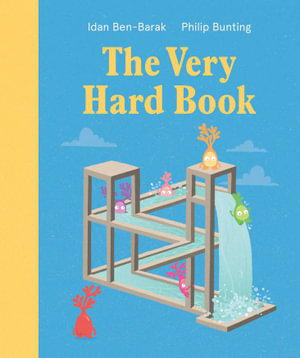The very hard book by Idan Ben-Barak and Philip Bunting

A book to deter readers from turning the pages, a book which encourages them to stop and think about what they are seeing, to talk about the words and images on each page, and pause to reflect. From the Escher style construction on the front cover to the invitation to the gallery as the book is opened, to the last endpaper containing a glossary of all the things seen in the book, this is an incentive to think, to muse, to inspire, to stimulate, to think about the thinking that goes on when a word and image is placed in front of them which confuses, delights, intrigues and befuddles. Can you be in an empty room, or be somewhere else for a minute, do something you don’t want to do, create a new colour? All of these and more are placed in front of the reader, stimulating them to think about their response and how they got to that response. Can you not think about purple turtles, or stop thinking for a minute, or stop you hair growing. All of these will stimulate discussion amongst the readers, strengthening their own metacognition, helping them to think about their own thoughts.
The last endpaper contains a catalogue of what the reader has seen in the gallery with further discussion prompts.
Philip Bunting’s illustrations will tease and delight, as readers follow the small creatures with antlers that lead them through the pages. Each page demands attention with its quirky illustration and pithy comment. It challenges the reader to take notice, not to turn the page but stop, sometimes laugh and think about what they are reading and seeing. Brain food in a book, designed to enhance the thinking skills of younger readers will also help to calm them, as quiet moments rule.
Themes: Metacognition, Thinking, Mental health, Thought processes, Humour.
Fran Knight